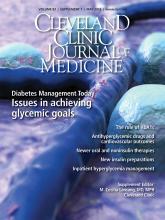Article Figures & Data
Tables
- TABLE 1
Noninsulin drugs for type 2 diabetes approved by the US Food and Drug Administration since 2005
Drug Year approved DPP-4 inhibitors Sitagliptin (Januvia) 2006 Saxagliptin (Onglyza) 2009 Linagliptin (Tradjenta) 2011 Alogliptin (Nesina) 2013 GLP-1 receptor agonists Short-acting (4–6 hrs) Exenatide (Byetta) 2005 Lixisenatide (Lyxumia) NDA submitted Intermediate-acting (24 hrs) Liraglutide (Victoza) 2010 Long-acting (7 days) Exenatide extended-release (Bydureon) 2012 Albiglutide (Tanzeum) 2014 Dulaglutide (Trulicity) 2014 SGLT-2 inhibitors Canagliflozin (Invokana) 2013 Dapagliflozin (Farxiga) 2014 Empagliflozin (Jardiance) 2014 Bile acid sequestrant Colesevelam (Welchol) 2008 Dopamine-receptor agonist Bromocriptine quick-release (Cycloset) 2009 DPP-4 = dipeptidyl peptidase-4; GLP-1 = glucagon-like peptide-1; NDA = new drug application; SGLT-2 = sodium-glucose cotransporter-2.
Dosing Sitagliptin (Januvia) Saxagliptin (Onglyza) Linagliptin (Tradjenta) Alogliptin (Nesina) With or without food 100 mg/day; oral 2.5–5 mg/day; oral 5 mg/day; oral 25 mg/day; oral Renal dose adjustment Reduce to 50 mg/day if CrCl 30–50 mL/min; reduce to 25 mg/day if < 30 mL/min or ESRD Reduce to 2.5 mg/day if CrCl < 50 mL/min or ESRD Fecal elimination route; no renal adjustment needed Reduce to 12.5 mg/day if CrCl 30–59 mL/min; reduce to 6.25 mg/day if < 30 mL/min or ESRD Hepatic dose adjustment No clinical experience with severe hepatic insufficiency (Child-Pugh score ≥ 9) None None No clinical trials in severe hepatic insufficiency (Child-Pugh grade C) Elimination half-life 12.4 hours 2.5 hours > 24 hours 12.5–21.1 hours Comments Low risk of hypoglycemia Long half-life; good choice for patients with chronic kidney disease Long half-life Similar glycemic efficacy as a class: Agents cause modest improvements in glycated hemoglobin levels
Overall, well tolerated; insufficient data regarding association with acute pancreatitisCrCl = creatinine clearance; DPP-4 = dipeptidyl peptidase-4; ESRD = end-stage renal disease.
Based on information in Tran L, Zielinski A, Roach AH, et al. Pharmacologic treatment of type 2 diabetes: oral medications. Ann Pharmacother 2015; 49:540–556.
Dosing (subcutaneous) Renal dosing Half-life; peak Side effects Short-acting (4–6 hours) Exenatide (Byetta) 5 μg twice daily; may increase to 10 μg twice daily after 4 weeks; take within 60 minutes of morning and evening meals; at least 6 hours apart Not recommended if CrCl < 30 mL/min 2.4 hours
Peak: 2.1 hoursWeight loss, GI upset Intermediate-acting (24 hours) Liraglutide (Victoza) Initial: 0.6 mg/day for 7 days
Maintenance: 1.2 mg/day; may increase to 1.8 mg/day, if needed
Body weight affects dosing: 1.2 mg and 1.8 mg doses provide adequate exposure for body weight ranges between 40–160 kg; has not been studied in body weight > 160 kgNo dose adjustment required but caution needed in patients with renal impairment ~13 hours
Peak: 8–12 hoursWeight loss, nausea Long-acting (7 days) Exenatide extended- release (Bydureon) 2 mg once/week Not recommended if CrCl < 30 mL/min Not available
Peaks: week 2 and week 6–7 (~10 weeks after discontinuation, plasma concentrations fall below minimal detectable levels)Weight loss, nausea Albiglutide (Tanzeum) Initial: 30 mg once/week; may increase to 50 mg once/week, if response inadequate Not recommended if eGFR < 15 mL/min/1.73 m2; use with caution in patients with renal impairment ~5 days
Peak: 3–5 daysWeight loss, nausea Dulaglutide (Trulicity) 0.75 mg once/week; may increase to 1.5 mg once/week, if needed
Available as prefilled pen or syringeNo dose adjustment required ~5 days
Peak: 24–72 hoursWeight loss, nausea CrCl = creatinine clearance; eGFR = estimated glomerular filtration rate; GI = gastrointestinal; GLP-1 = glucagon-like peptide-1.
Based on information in Tran L, Zielinski A, Roach AH, et al. Pharmacologic treatment of type 2 diabetes: injectable medications. Ann Pharmacother 2015; 49:700–714.
Medication Dosing Renal dose adjustment HbA1c reduction; monotherapy HbA1c reduction; add-on Hypoglycemia risk; monotherapy Added benefits Side effects/ disadvantages SGLT-2 inhibitors Canagliflozin 100 mg once/day; can titrate to 300 mg/day eGFR 45–60, ≤ 100 mg/day;
eGFR < 45, avoid0.91%–116% 0.37%–0.92% Low Weight loss, decreased blood pressure, works at all stages of type 2 diabetes mellitus Genitourinary infections, mild increase LDL, volume depletion/ dizziness, transient increase in creatinine, less effective with decreased eGFR, euglycemic DKA Dapagliflozin 5 mg once/day; can titrate to 10 mg/day eGFR < 60, avoid 0.54%–0.66% 0.4%–0.69% Low Empagliflozin 10 mg once/day; can titrate to 25 mg/day eGFR < 45, avoid 0.74%–0.85% 0.38%–0.64% Low Bile acid sequestrants Colesevelam 3.75 g once/day
1.875 g twice/dayNo 0%–0.5% 0.3%–0.5% Low Decreased LDL, weight neutral Increased triglycerides, constipation, decreased absorption of other medications Dopamine-receptor agonists Bromocriptine quick release 0.8 mg once/day; titrate by 0.8 mg weekly until 1.6–4.8 mg/day achieved No 0.55% (single study) 0.4%–0.7% Low Possible decreased CV events, weight neutral Nausea, headache, diarrhea, fatigue CV = cardiovascular; DKA = diabetic ketoacidosis; eGFR = estimated glomerular filtration rate with units as mL/min/1.72m2; HbA1c = hemoglobin A1c; LDL = low-density lipoprotein; SGLT-2 = sodium-glucose cotransporter-2.
Based on information in Tran L, Zielinski A, Roach AH, et al. Pharmacologic treatment of type 2 diabetes: oral medications. Ann Pharmacother 2015; 49:540–556.






